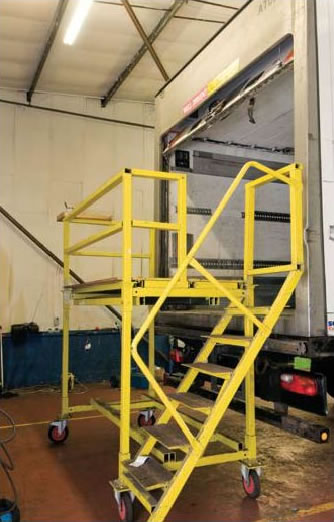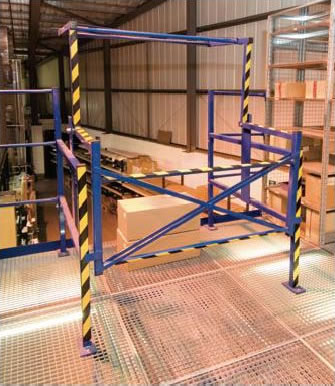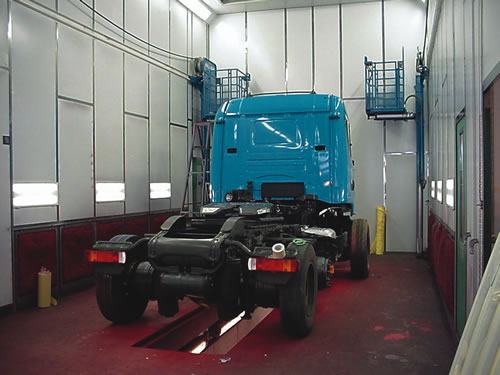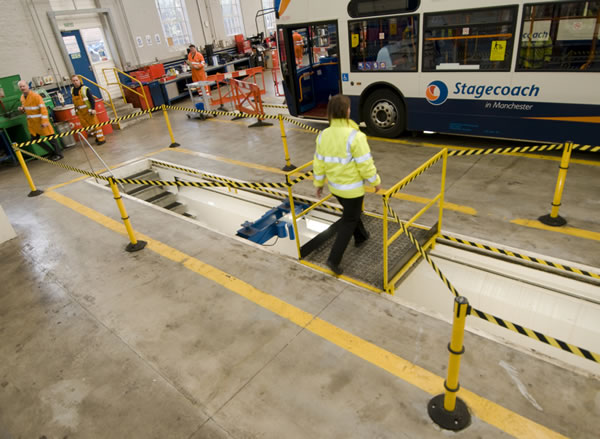Falls from height are the most common cause of death and serious injury to people at work and are the cause of nearly 10% of injuries in motor vehicle repair MVR. The main cause is falling from ladders.
Practical methods for controlling the risks
Provide mobile platforms for vehicle access.

Workplace maintenance, cleaning, and repair at height
Provide appropriate access equipment and ensure it is well maintained and used. Train workers in its safe use.

Raised storage areas
Raised storage areas include top of offices and mezzanine floors.
Where practicable, provide permanent access. Otherwise ladders should be secured. Provide guard rails around open edges.

Tops of commercial vehicles and trailer units under repair
Provide proper access to any work at height and means to prevent persons from falling.

Vehicle Inspection pits or rolling roads
Mark edges of all openings in floors, fence or board them when not in use. Ensure good lighting levels. Control customer access.
Work at Height Regulations
The Work at Height Regulations apply to all work at height where there is a risk of a fall liable to cause personal injury.
They place duties on employers, the self-employed, and any person that controls the work of others (for example facilities managers or building owners who may contract others to work at height).
Experience shows that such events usually arise due to poor management control rather than equipment failure. In MVR, risk assessments should include:
- work at height on vehicles
- prevention of falls into vehicle inspection pits
- working on raised storage areas
- use of portable ladders for access to vehicles; building maintenance
- safety of stairs, steps, fixed ladders
Examples of falls from height incidents
Here are some examples of how and why falls from height incidents have occurred.
Unsecured ladder - a person working on a box trailer vehicle fell 4 metres from the top of an extension ladder sustaining multiple fractures to their hip and left wrist. The ladder was not footed or secured and they lost their balance when the bottom of the ladder slipped away. Their employer had not carried out a risk assessment and there was no safety equipment provided for work on the tops of commercial vehicles.
Missing barrier - a worker had gone onto a storage area above an office. Permanent access and guardrails were in place, but on the day of the accident the barrier that normally prevented persons going onto a non-load bearing part of the office roof was missing. When someone in the office below called out to the worker, they stepped onto the fragile section of the roof and fell to the floor below. They sustained 2 cracked ribs. Management was not aware that the barrier had been removed and there was no warning of the danger.
No safety equipment and lack of training - a 17 year old apprentice was clearing the gutters on the workshop roof when they fell through a fragile roof-light onto the concrete floor 5 metres below. They fractured their pelvis in 3 places. For convenience, their employer had always used unsupervised and untrained apprentices to carry out this work. There was no risk assessment no appropriate safety equipment available.
Reversing vehicle over an inspection pit - a worker was assisting a driver position a vehicle over an inspection pit. They were walking backwards when they fell about 1.5 metres into the pit sustaining 3 broken ribs and a broken left wrist. Both the driver and the other worker had ignored management's safety procedures published in the company's induction pack which warned of the danger of reversing in this way.
No working platform - a paint sprayer fell from a stepladder whilst spraying a lorry and was left with broken ribs, broken collarbone, and a shattered shoulder. The same sprayer had fallen off the same stepladder a month before but no action was taken by their employer. They should have identified that a working platform was necessary for this spraying work. The company went into voluntary liquidation but were still prosecuted by HSE.